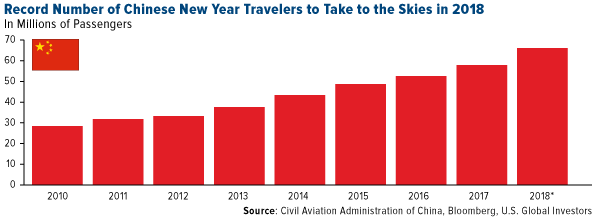
Last Friday marked the first day of the Chinese Lunar New Year, also known as the Spring Festival, China’s most important holiday. The fire rooster struts off-stage, clearing the way for the loyal earth dog. According to CLSA’s tongue-in-cheek Feng Shui Index, healthcare, consumer, and paper products are favored to outperform early this year, followed by internet, utilities and tech leading into the summer.
Around this time I always pay close attention to transportation and industrials. “Chunyun,” which translates to “Spring Festival Transportation,” is a 40-day travel season that’s known as the world’s largest human migration. This year, as many as 390 million Chinese travelers—more people than live in the U.S. and Canada combined—are forecast to put roads, highways, passenger trains and airlines through their paces as they visit families, go on vacation and travel abroad. Airlines alone are expected to serve 65 million passengers, a 10 percent increase from last year.

As the size of China’s middle class continues to surge and incomes rise, this upward trend in flight demand and overall consumer spending appears sustainable, creating some very attractive investment opportunities.
Below are five additional things I think investors should know about China and the surrounding region in the New Year.
1. China is a veritable wealth factory.

Speaking of disposable income: Last year, the China region added more new billionaires than the U.S. for the first time ever. UBS and PricewaterhouseCoopers’ (PwC) annual report on billionaires found that the total number of Asian billionaires rose to 637, followed by the U.S. (563) and Europe (342). China alone minted 67 new billionaires in 2017 and is now home to nearly 320.
Combine this with a surging middle class—already the largest in the world—and the consequences on consumption could be huge.
As I’ve shared with you before, China is still in the early stages transitioning from a manufacturing to a consumption and services-based economy. According to the World Economic Forum (WEF), Chinese household income is projected to grow around 5 percent annually between now and 2027, elevating approximately 180 million people into the middle-income bracket. This will contribute to greater demand for everything from appliances to smartphones to automobiles to luxury goods.













Leave A Comment